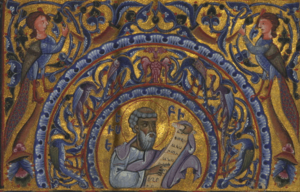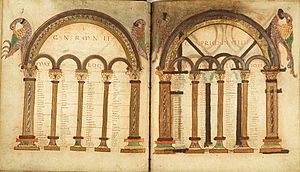Eusebius facts for kids
Quick facts for kids
Eusebius of Caesarea
|
|
|---|---|
A 6th-century picture of St. Eusebius of Caesarea from the Rabbula Gospels
|
|
| Born | c. 260–265 Caesarea Maritima |
| Died | 30 May 339 |
| Occupation | Bishop, historian, theologian |
| Period | Constantinian dynasty |
| Notable works | Ecclesiastical History, On the Life of Pamphilus, Chronicle, On the Martyrs |
| Saint Eusebius of Caesarea |
|
|---|---|

A saintly picture of Eusebius of Caesarea from a 1262 Armenian Gospel book
|
|
| The Father of Church History | |
| Venerated in | Syriac Orthodox Church |
| Feast | May 30 (ancient Syrian Church) February 29 (Syrian Orthodox) June 21 (Roman Catholic; Suppressed by Pope Gregory XIII) |
| Influences | Origen, St. Pamphilus of Caesarea, St. Constantine the Great, Sextus Julius Africanus, Philo, Plato |
| Influenced | St. Palladius of Galatia, St. Basil the Great, Rufinus of Aquileia, St. Theodoret of Cyrus, Socrates of Constantinople, Sozomen, Evagrius Scholasticus, Gelasius of Cyzicus, Michael the Syrian, St. Jerome, Philostorgius, Victorius of Aquitaine, Pope St. Gelasius I, Pope Pelagius II, Henri Valois, George Bull, William Cave, Samuel Lee, J.B. Lightfoot, Henry Wace |
Eusebius of Caesarea (born around 260–265 AD, died May 30, 339 AD) was an important Greek historian of Christianity. He was also a theologian, meaning he studied religious beliefs. People often called him Eusebius Pamphilus because of his close connection to his teacher, Pamphilus.
Around 314 AD, Eusebius became the bishop of Caesarea Maritima. This city was in the Roman province of Syria Palaestina. He was known as one of the most educated Christians of his time. He wrote many books about the Bible and Christian history. His most famous work is the Ecclesiastical History. He also wrote a book about Constantine the Great, the first Christian Roman emperor.
Contents
Early Life and Education
Most experts believe Eusebius was born between 260 and 265 AD. He likely grew up in or near Caesarea Maritima. We don't know anything about his parents. He was baptized and educated in Caesarea. In 296 AD, he saw Constantine traveling with the Roman army.
Eusebius became a presbyter (a type of priest) under Agapius of Caesarea. Some scholars think he was a student of Dorotheus of Tyre. Dorotheus was known for explaining the Scriptures wisely.
Caesarea: A Center for Christian Learning
Caesarea became a major center for Christian learning. This was thanks to the theologian Origen (who lived from 185/6–254 AD). Origen's student, Pamphilus, continued his work. Origen collected information about which Christian writings were used by different churches. This information helped decide which books became part of the New Testament. Eusebius later used Origen's notes in his own Ecclesiastical History.
When Origen died, he left his large library to the Christian community. Pamphilus used these books to create a new library and school. This school was similar to Origen's. Pamphilus was praised for gathering Bibles from all over the world. He worked closely with his students, including Eusebius.
Eusebius and Pamphilus
Pamphilus began teaching Eusebius around the 280s. Eusebius was then in his early twenties. Their close bond led to Eusebius being called Eusebius Pamphili. This means "Eusebius, son of Pamphilus." It might also mean Eusebius was Pamphilus's chosen heir. Pamphilus taught Eusebius to admire Origen's ideas.
The school focused on sacred learning. The library had many important biblical and theological books. These included Origen's Hexapla and Tetrapla. Pamphilus and his students, including Eusebius, worked to correct and improve biblical texts.
Early Writings
Around the 290s, Eusebius started his most important work. This was the Ecclesiastical History. It tells the story of the Christian Church from the time of the Apostles to his own era. At the same time, he began his Chronicle. This was a timeline of world events from the Creation to his present day. He finished the first versions of both works before 300 AD.
Bishop of Caesarea
Eusebius became the Bishop of Caesarea shortly after 313 AD. He took over from Agapius. He became involved in a major religious debate. This was the Arian controversy. Arius was a priest who taught that Jesus was not fully equal to God the Father. Arius was excommunicated (removed from the church) by his bishop.
Eusebius supported Arius at first. A church council in Caesarea even said Arius was innocent. Eusebius was also favored by Emperor Constantine. Because of this, he was asked to present his church's beliefs at the First Council of Nicaea in 325 AD. However, the council chose a different creed. This became the basis for the Nicene Creed, which stated Jesus was fully divine.
The debate over Arius's ideas continued. Eustathius of Antioch accused Eusebius of not following the Nicene faith. But Eusebius remained powerful. Eustathius was removed from his position.
Later, Athanasius of Alexandria became a strong opponent of Arius's views. Eusebius presided over a council in Tyre that condemned Athanasius. Athanasius then appealed directly to Emperor Constantine. Constantine called the bishops, including Eusebius, to his court. Athanasius was exiled. Eusebius remained in the Emperor's good graces.
After Constantine's death around 337 AD, Eusebius wrote Life of Constantine. This book is important because Eusebius was an eyewitness to many events. He also used original documents.
Eusebius's Writings
Eusebius wrote a lot, and many of his works have survived. Even though some people later questioned his beliefs, his writing methods were very useful. He carefully copied parts from older writings. This saved many important historical texts that would have been lost otherwise.
His writings show the different stages of his life. First, he focused on studying the Bible. This was influenced by Pamphilus. Then, the persecutions of Christians made him write about martyrs. This led him to write about the history of the entire Church. After that, he wrote about the Arian debates. When Christianity was accepted by the Roman Empire, he wrote works defending the faith. Finally, he wrote praises for Emperor Constantine. He also wrote many other works, including commentaries on the Bible.
Biblical Text Studies
Pamphilus and Eusebius worked on improving the texts of the Septuagint (the Greek Old Testament) and the New Testament. Eusebius created a system to help people find passages in the four Gospels. He divided the Gospels into sections. He then made tables that showed where similar stories appeared in different Gospels. These "Eusebian canons" were used throughout the Middle Ages. They are often beautifully decorated in old Gospel books.
The Chronicle
The Chronicle was a universal history. It was divided into two parts. The first part summarized world history by different nations. The second part showed historical events in parallel columns, like a timeline.
The original Greek version of the Chronicle is mostly lost. But we have a Latin translation by Jerome. We also have a complete Armenian translation. This Armenian version is very important because it preserves much of the original work. The Chronicle covers history up to the year 325 AD.
The Church History
Eusebius's Church History (also called Ecclesiastical History) is the first surviving history of the Christian Church. It tells the story of the Church in order, from the time of the Apostles to Eusebius's own day. He connected Church history with the reigns of the Roman Emperors. The book covers bishops, teachers, Christian relations with Jews, and Christian martyrs. It goes up to 324 AD. Even though some question its accuracy, it is a very important source for learning about the early Church. This is because Eusebius had access to many documents that are now lost.
The Life of Constantine
Eusebius's Life of Constantine is a work praising the emperor. Because it's a praise piece, it doesn't always give a full picture of events. The historian Socrates Scholasticus said that Eusebius focused more on praising Constantine than on exact facts. Eusebius did not finish this work before he died.
Constantine's Vision
Eusebius wrote that Emperor Constantine told him about a special vision. This happened before a big battle against his rival, Maxentius. Constantine and his soldiers saw a Christian symbol in the sky. It looked like a cross made of light, above the sun at midday. With the symbol, there was a message: "by this conquer."
That night, Jesus appeared to Constantine in a dream. He told Constantine to make a copy of the symbol and use it for protection. Eusebius said this happened during one of Constantine's military campaigns. It's not clear if the symbol was a cross or another Christian sign.
Other historical accounts of this time do not mention this vision. For example, the Arch of Constantine, built in 315 AD, doesn't show any Christian symbols related to the battle. However, Eusebius's account is a key part of the story of Constantine's conversion.
Other Important Works
Eusebius also wrote other historical works. He collected stories of martyrs from earlier times. He also wrote a biography of Pamphilus, his teacher. A work about the martyrs in Palestine during the time of Emperor Diocletian was written after 311 AD.
He also wrote works defending Christian beliefs:
- Praeparatio evangelica (Preparation for the Gospel): This book tries to show that Christianity is better than other pagan religions and philosophies. It has fifteen books that have all survived. Eusebius meant it as an introduction to Christianity for non-Christians. It is valuable today because Eusebius included many quotes from ancient historians and philosophers that are not found anywhere else.
- Demonstratio evangelica (Proof of the Gospel): This work is connected to the Praeparatio. It originally had twenty books, with ten fully preserved. Here, Eusebius writes about Jesus Christ.
Eusebius also wrote commentaries on parts of the Bible, like the Psalms and Isaiah. He also wrote a book called On the Differences of the Gospels. This book tried to explain and harmonize any differences in the stories told by the different Gospel writers.
Eusebius's Beliefs
Eusebius believed that God is the absolute ruler of everything. God is the source of all good things and all life. He believed that God sent Christ so that people could share in God's goodness. Eusebius saw Jesus as distinct from God the Father, much like a ray of light is distinct from the sun.
He also believed that people choose to be sinners. It is not because of their nature.
There is a story that Eusebius refused to make images of Christ for Constantine's daughter. This story was used later in debates about religious images.
Death
Eusebius of Caesarea likely died in 339 or 340 AD, probably from old age.
Veneration
Eusebius is considered a saint by some Christian churches. The earliest record of his feast day is in a Syrian Martyrology from 411 AD, which lists it as May 30. The modern Syriac Orthodox Church still honors him as a saint, with a feast day on February 29.
He was also honored in the Roman Catholic Church for a long time. However, during a revision of the Roman Martyrology under Pope Gregory XIII, his name was removed. This was due to a mistake, as another Saint Eusebius was put in his place. Despite this, some older Catholic texts and traditions still remember him as a saint.
A small bone fragment believed to be a relic of Saint Eusebius is displayed at St. Martha's Catholic Church in Morton Grove, Illinois.
Images for kids
See also
 In Spanish: Eusebio de Cesarea para niños
In Spanish: Eusebio de Cesarea para niños





